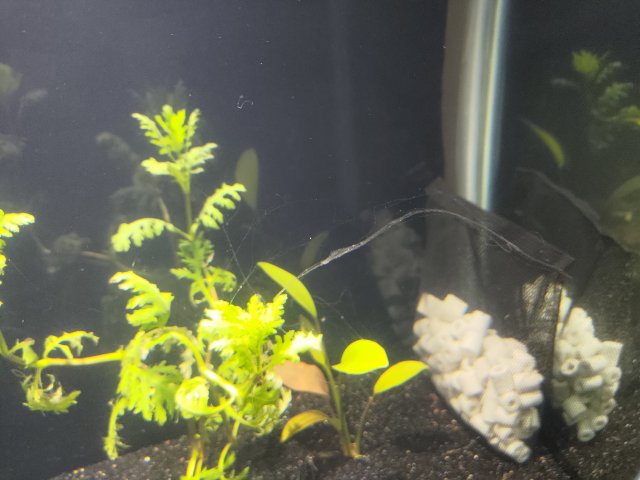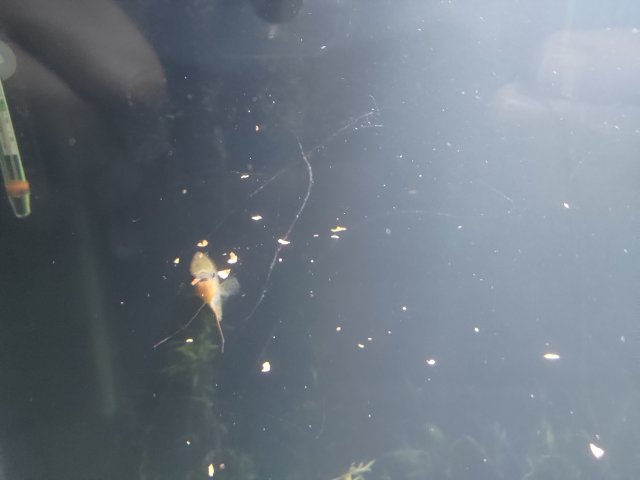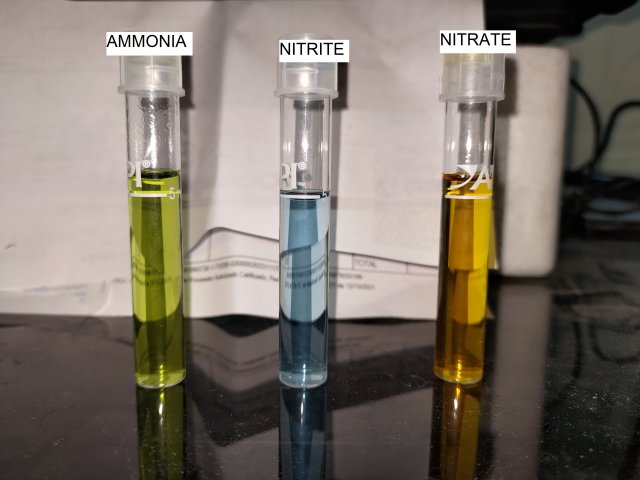You are doing a few things incorrectly. In order to determine what the actual reading is you need to hold the vial against the whit part of the card next to the bars for what it is testing, next, you need to obserce the result in good light coming from behind you. The reason for ewhat I am saying is so the same light hits the bars on the card as the vial itself.
As far As i could tell fromwhat your pictures show you do not have any ammonia. Next, I am sure you have not been educated on ammonia in water and what your test measures, so
1. Ammonia is a gas and its chemical formula is NH3.
2. When ammonia is dissolved in water, most of it turns into Ammonium which is NH4. Is ans ion as it has a charge while ammonia is neutral.
3. How much of the ammonia is in each form depedns upon two main factor- the pH of he water and the temperature of the water. The high these two numbers are the more of the ammonia will be in the NH3 form.
4. Ammonia (NH#3) is extrememly toxic to fish. Levels as low as 0.05 ppm can begin causing harm in some fish. Ammonium (NH4) is way less harmful. However with enough NH$ and a long enough time of exposure, it will also harm fish.
5. Most of our hobby test kits test for Total Ammonia (TA) which is the sum of both NH3 + NH4. However, the number we really need to know is how much of the TA is NH3. There is some complex math that enables this to be done. But this is the digital age and there are now online ammonia calculators.
5b. I use an ammonia calculator. Because I have written several articles on cycling for another major site which is in the same style as AC, I am going to repeat myself here by quoting what I wrote on this topic:
SOME IMPORTANT FACTS ABOUT AMMONIA
Ammonia in water exists in two forms.
NH3, which is the familiar nasty gas we know. Fish exhale NH3. Rotting organic matter will also create ammonia. This stuff is highly toxic and will definitely be harming fish by the time it reaches a concentration of .05 ppm (Some fish and inverts need even lower levels to be safe). However, most of the ammonia in water exists in the form of ammonium which is
NH4. This is way less harmful. But in sufficient concentrations and/or exposure times, it causes external burns. The typical test kits we use measure
Total Ammonia (TA) which is the sum of both NH3 and NH4.
Knowing how dangerous any level of TA might be requires that one know not only how much total ammonia there is but also how much of that total is in each form? The answer depends upon two other water parameters- pH and temperature. The higher the pH and/or temperature, the more of the TA that is in the toxic NH3 form. To calculate how much of the toxic NH3 form of ammonia requires that you know what the
pH and
temperature of your tank water are. Once you know all three numbers (total ammonia, pH and temperature) there is a formula for calculating how much of the total ammonia is in the form of NH3. It is way more complicated to use than most of us can handle. Fortunately, there are charts and tables available for this calculation. There is also currently a handy dandy ammonia calculator you can find here:
http://www.hamzasreef.com/Contents/Calculators/FreeAmmonia.php
1. Choose NH (NH3 + NH4)*
2. Enter in the total ammonia reading from your test, choose ppm.
3. For a fresh water tank, enter 0 for the salinity.
4. Enter your tank’s current pH.
5. Enter your tank temperature and choose F or C, whichever applies.
6. Click Calculate.
The number you want to know is the one for
NH3.
[* If your kit measures ammonia as nitrogen aka –N, choose NH-N (NH3-N + NH4-N) in step 1. above.]
Why do you want this number? Because, to get a tank cycled you need to have ammonia (and nitrite) present and you want to have as much total ammonia present as possible without causing permanent harm to the fish. And it is the NH3 that will cause the real harm. Your goal is to allow the total ammonia to rise as high as possible as long as the NH3 content does not get to .05 ppm using that calculator. And even if that level of NH3 is not reached, there is still a limit to how high one can allow total ammonia to rise.
Remember, NH4 can still cause ammonia burns. This writer’s normal cutoff for total ammonia for more than a few days or so is 2 ppm. As a rule of thumb, you can run at 2 ppm of total ammonia with the NH3 being well under .05 for some short amount time. The lower it is under .05, the better. At under .02 ppm of NH3 many fish can be in up to 2 ppm for a number of days and still be OK. The best sign of how long is how the fish behave. If they act distressed, then that is high and/or long enough. Some fish can manage in higher levels, others can’t. This is why you must also watch the fish as well as the test levels.
Hint: As a rule, problems from ammonia become increasingly serious as one’s pH goes above 8.0 and by 8.5 one must really be doing a fishless cycle only. This is very relevant for those keeping rift lake cichlids
There are two goals in fish in cycling which are diametrically opposed. One is to allow ammonia and nitrite to get high enough to get the cycle done as quickly as possible. The other is to keep the ammonia and nitrite from being high enough to cause permanent harm to the fish. Every water change slows the cycle. But the failure to do one at the proper time can harm or even kill the fish.
SIGNS OF AMMONIA POISONING
Fish will not behave as they normally do. Signs of ammonia poisoning can include sluggish behavior, panting, and gill discoloration (gill burn). Fish may hang just below the water surface or they may hide or stop eating. When you know you have ammonia in the tank during cycling and you notice such behavioral changes, the best course of action, regardless of test results, it to do an immediate water change of 50% or more.
If you also need help with understanding chlorine and chloramine and the differneces and similarities and how to deal with them, I can offer help on this as well.







